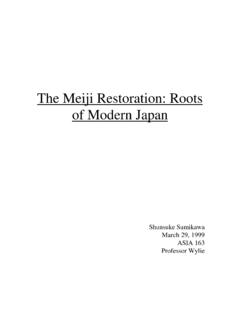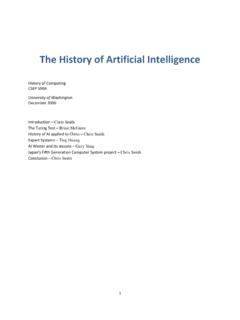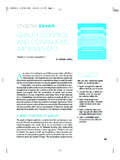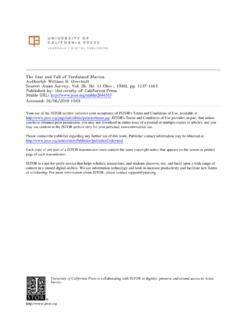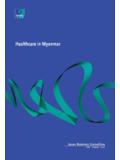Transcription of The clash of civilizations? - Columbia University
1 Monday, July 24, 2000 DocumentPage: 1 clash of civilizations? Foreign Affairs; New York; Summer 1993; Huntington, Samuel P; Volume: 72 Issue: 3 Start Page: 22 ISSN: 00157120 Subject Terms: TrendsStudiesSocial researchRelationsPolitical behaviorManycountriesImpactsCultureConfl ictsMulticulturalism & pluralismMinority & ethnic violenceInternational relations-USClassification Codes: 9550: Public sector organizations9180: International9130: Experimental/theoretical treatment1200: Social policyGeographic Names: United StatesUSAbstract:World politics is entering a new phase in which the great divisions among humankind and the dominating source of conflict will be , the highest cultural groupings of people, are differentiated from each other by religion, history, language, and divisions are deep and increasing in importance. From Yugoslavia to the Middle East to Central Asia, the fault lines of civilizationsare the battle lines of the future.
2 In this emerging era of cultural conflict, the US must forge alliances with similar cultures and spread itsvalues wherever possible. With alien civilizations, the West must be accommodating if possible, but confrontational if necessary. In thefinal analysis, however, all civilizations will have to learn to tolerate each other. Full Text:Copyright Council on Foreign Relations Summer 1993 THE NEXT PATTERN OF CONFLICTW orld politics is entering a new phase, and intellectuals have not hesitated to proliferate visions of what it will be--the end of history, the return oftraditional rivalries between nation states, and the decline of the nation state from the conflicting pulls of tribalism and globalism, among others. Eachof these visions catches aspects of the emerging reality. Yet they all miss a crucial, indeed a central, aspect of what global politics is likely to be in thecoming is my hypothesis that the fundamental source of conflict in this new world will.
3 Not be primarily ideological or primarily economic. The greatdivisions among humankind and the dominating source of conflict will be cultural. Nation states will remain the most powerful actors in world affairs,but the principal conflicts of global politics will occur between nations and groups of different civilizations. The clash of civilizations will dominateglobal politics. The fault lines between civilizations will be the battle lines of the between civilizations will be the latest phase in the evolution of conflict in the modern world. For a century and a half after the emergence ofthe modern international system with the Peace of Westphalia, the conflicts of the Western world were largely among princes--emperors, absolutemonarchs and constitutional monarchs attempting to expand their bureaucracies, their armies, their mercantilist economic strength and, mostimportant, the territory they ruled.
4 In the process they created nation states, and beginning with the French Revolution the principal lines of conflictwere between nations rather than princes. In 1793, as R. R Palmer put, "The wars of kings were over; the wars of peoples had begun." Thisnineteenth-century pattern lasted until the end of World War I. Then, as a result of the Russian Revolution and the reaction against it, the conflict ofnations yielded to the conflict of ideologies, first among communism, fascism-Nazism and liberal democracy, and then between communism and liberaldemocracy. During the Cold War, this latter conflict became embodied in the struggle between the two superpowers, neither of which was a nationstate in the classical European sense and each of which defined its identity in terms of its conflicts between princes, nation states and ideologies were primarily conflicts within Western civilization , "Western civil wars," as WilliamLind has labeled them.
5 This was as true of the Cold War as it was of the world wars and the earlier wars of the seventeenth, eighteenth and nineteenthcenturies. With the end of the Cold War, international politics moves out of its Western phase, and its centerpiece becomes the interaction betweenthe West and non-Western civilizations and among non-Western civilizations. In the politics of civilizations, the peoples and governments ofnon-Western civilizations no longer remain the objects of history as targets of Western colonialism but join the West as movers and shapers NATURE OF CIVILIZATIONSD uring the Cold War the world was divided into the First Second and Third Worlds. Those divisions are no longer relevant. It is far more meaningfulnow to group countries not in terms of their political or economic systems or in terms of their level of economic development but rather in terms oftheir culture and , July 24, 2000 DocumentPage: 2 do we mean when we talk of a civilization ?
6 A civilization is a cultural entity. Villages, regions, ethnic groups, nationalities, religious groups, allhave distinct cultures at different levels of cultural heterogeneity. The culture of a village in southern Italy may be different from that of a village innorthern Italy, but both will share in a common Italian culture that distinguishes them from German villages. European communities, in turn, willshare cultural features that distinguish them from Arab or Chinese communities. Arabs, Chinese and Westerners, however, are not part of any broadercultural entity. They constitute civilizations. A civilization is thus the highest cultural grouping of people and the broadest level of cultural identitypeople have short of that which distinguishes humans from other species. It is defined both by common objective elements, such as language, history,religion, customs, institutions, and by the subjective self-identification of people.
7 People have levels of identity: a resident of Rome may definehimself with varying degrees of intensity as a Roman, an Italian, a Catholic, a Christian, a European, a Westerner. The civilization to which he belongsis the broadest level of identification with which he intensely identifies. People can and do redefine their identities and, as a result, the compositionand boundaries of civilizations may involve a large number of people, as with China ("a civilization pretending to be a state," as Lucian Pye put it), or a very smallnumber of people, such as the Anglophone Caribbean. A civilization may include several nation states, as is the case with Western, Latin Americanand Arab civilizations, or only one, as is the case with Japanese civilization . Civilizations obviously blend and overlap, and may includesubcivilizations. Western civilization has two major variants, European and North American, and Islam has its Arab, Turkic and Malay are nonetheless meaningful entities, and while the lines between them are seldom sharp, they are real.
8 Civilizations are dynamic; they riseand fall, they divide and merge. And, as any student of history knows, civilizations disappear and are buried in the sands of tend to think of nation states as the principal actors in global affairs. They have been that, however, for only a few centuries. The broaderreaches of human history have been the history of civilizations. In A Study of History, Arnold Toynbee identified 21 major civilizations; only six ofthem exist in the contemporary CIVILIZATIONS WILL CLASHC ivilization identity will be increasingly important in the future, and the world will be shaped in large measure by the interactions among seven oreight major civilizations. These include Western, Confucian, Japanese, Islamic, Hindu, Slavic-Orthodox, Latin American and possibly Africancivilization. The most important conflicts of the future will occur along the cultural fault lines separating these civilizations from one will this be the case?
9 First, differences among civilizations are not only real; they are basic. Civilizations are differentiated from each other by history, language, culture,tradition and, most important, religion. The people of different civilizations have different views on the relations between God and man, the individualand the group, the citizen and the state, parents and children, husband and wife, as well as differing views of the relative importance of rights andresponsibilities, liberty and authority, equality and hierarchy. These differences are the product of centuries. They will not soon disappear. They arefar more fundamental than differences among political ideologies and political regimes. Differences do not necessarily mean conflict, and conflict doesnot necessarily mean violence. Over the centuries, however, differences among civilizations have generated the most prolonged and the most , the world is becoming a smaller place The interactions between peoples of different civilizations are increasing; these increasing interactionsintensify civilization consciousness and awareness of differences between civilizations and commonalities within civilizations.
10 North Africanimmigration to France generates hostility among Frenchmen and at the same time increased receptivity to immigration by "good" European CatholicPoles. Americans react far more negatively to Japanese investment than to larger investments from Canada and European countries. Similarly, asDonald Horowitz has pointed out, "An Ibo may Owerri Ibo or an Onitsha Ibo in what was the Eastern region of Nigeria. In Lagos, he issimply an Ibo. In London, he is a Nigerian. In New York, he is an African." The interactions among peoples of different civilizations enhance thecivilization-consciousness of people that, in turn, invigorates differences and animosities stretching or thought to stretch back deep into , the processes of economic modernization and social change throughout the world are separating people from long-standing local also weaken the nation state as a source of identity.










